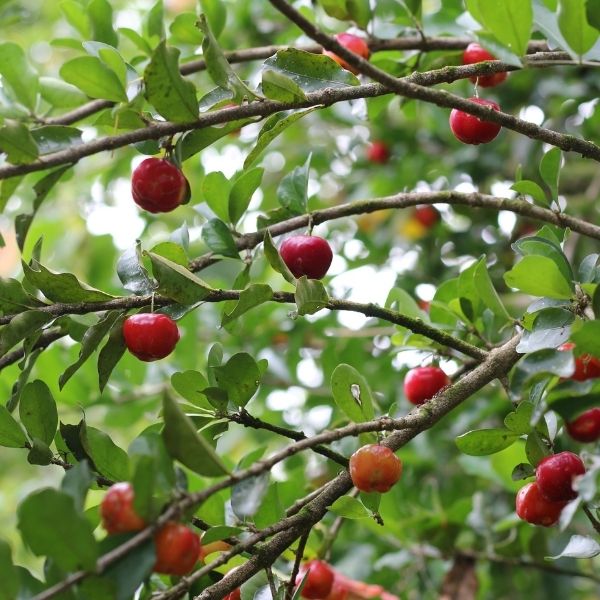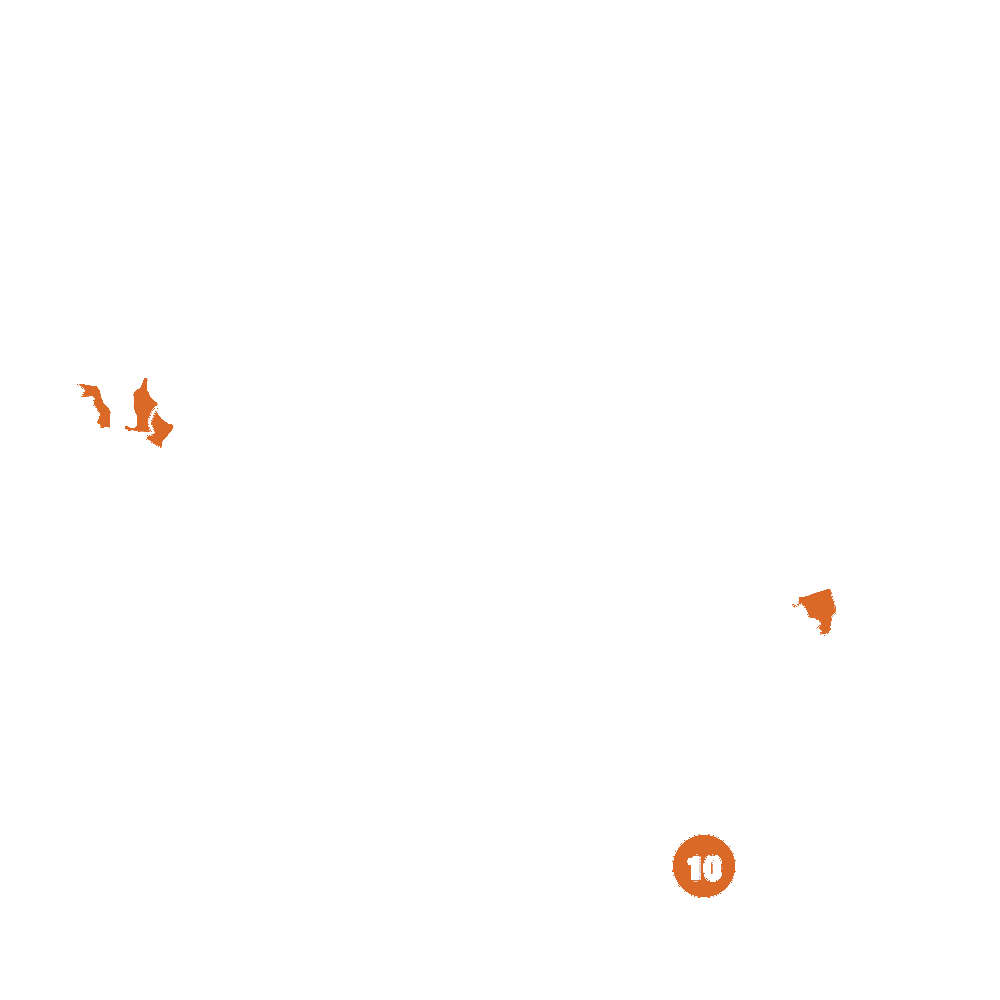
Barbados Cherry
Malpighia emarginata
92 reviews
Barbados Cherry
Malpighia emarginata
92 reviews
1 Gallon
We are sorry, product is currently out of stock due to seasonal availability. Please check the "Related plants available in your area" section below
Not just beautiful - intentionally selected by ShrubHub's 3D landscape design team to fit real-world spaces and maximize yard potential.
Why Barbados Cherry?
The Barbados cherry (Malpighia emarginata) is a popular fruit mainly grown in warm climates. It is renowned for its high vitamin C content, providing the human body with numerous health benefits. The cherry-like fruit is small, bright red, and has a tangy, sweet flavor. It is commonly used in juices, jellies, and jams, making it a versatile and delicious addition to various culinary creations.
Sunlight
Barbados Cherry plants require full sun exposure to thrive. They need at least six to eight hours of direct sunlight daily to ensure proper growth and fruit production.
Watering
Barbados Cherry requires regular watering, but it is important not to overwater. It prefers moist soil, so aim to water it when the top layer of soil feels dry to the touch.
Fertilizing
Barbados Cherry requires a balanced fertilizer with a ratio of nitrogen, phosphorus, and potassium (NPK) of 10-10-10 or similar. Regular fertilization in spring and summer is recommended for optimal growth and fruit production.
Barbados Cherry (Malpighia emarginata)
The Barbados Cherry, scientifically known as Malpighia emarginata, is a tropical evergreen shrub or small tree native to the Caribbean islands, as well as Central and South America. It is highly valued for its small, bright red fruits that resemble cherries, hence the common name.
Appearance and Growth
The Barbados Cherry plant typically grows up to 10 feet tall and has a dense, bushy habit with glossy, medium green leaves. The leaves are oval-shaped and about 1 to 4 centimeters long. The plant produces small, fragrant, pink or white flowers that bloom throughout the year, followed by the formation of the cherry-like fruits.
Fruits and Flavor
The Barbados Cherry is renowned for its delicious fruits, which are rich in Vitamin C and other antioxidants. The fruits have a tangy, slightly sweet flavor with a hint of tropical tartness. They are typically two to three centimeters in diameter, with a firm flesh and thin skin.
Cultivation and Uses
The Barbados Cherry thrives in warm tropical climates and is often grown as an ornamental plant as well as for its fruit. It is suitable for both gardens and container cultivation. The plant prefers well-drained soils and full sun exposure but can tolerate some shade. It is also relatively drought-tolerant once established.
In addition to its ornamental and fruit-bearing qualities, the Barbados Cherry has medicinal uses as well. The fruits are rich in Vitamin C, making them beneficial for boosting the immune system and overall health. They are also used in the preparation of juices, jams, jellies, and various culinary creations.
Care and Maintenance
To ensure the healthy growth of Barbados Cherry, regular watering is essential, especially during dry periods. Pruning can be done to control the size and shape of the plant. Fertilization with a balanced, slow-release fertilizer is recommended to provide essential nutrients.
Pest and Disease Control
The Barbados Cherry is generally resistant to pests and diseases. However, it can occasionally be susceptible to aphids, scale insects, and spider mites. Regular monitoring and appropriate treatments, such as insecticidal soaps or horticultural oils, can help manage these issues if they arise.
Summary
The Barbados Cherry is a versatile and attractive plant that offers both ornamental beauty and delicious, nutritious fruits. With its year-round flowering and fruiting, it brings a touch of the tropics to any garden or container. Whether you wish to enjoy the fruits fresh, use them in culinary creations, or enhance your overall well-being with their health benefits, the Barbados Cherry is a fantastic choice.
Plant Information:
| Botanical Name: | Malpighia emarginata |
| USDA Zones: | 9 - 12 |
| Water: | Moderate |
| Exposure: | Full Sun |
| Soil Needs: | Well Drained Soil |
| Mature Height: | 12 - 18 feet |
| Mature Spread: | 10 - 15 feet |



Pollination Info
Pollination Information for Barbados Cherry (Malpighia emarginata)
The Barbados Cherry, also known as acerola or West Indian cherry, is a small tropical fruit tree native to the Caribbean islands and Central America. It is highly valued for its high vitamin C content and antioxidant properties.
Pollination
Barbados Cherry trees are self-fruitful, meaning they have the ability to set fruit with their own pollen. However, cross-pollination can improve fruit quality and yield. In its natural habitat, the Barbados Cherry is primarily pollinated by bees, butterflies, and other flying insects attracted to its vibrant flowers.
Flower Characteristics
The Barbados Cherry tree produces small, pink to red flowers that are about 0.5 to 1 inch in diameter. The flowers have five petals and a prominent yellow center. They are usually solitary or in small clusters at the leaf axils.
Pollen Production
The flowers of the Barbados Cherry tree produce a moderate amount of pollen. The pollen grains are relatively large and sticky, making them suitable for cross-pollination with the help of insect vectors.
Pollinator Attraction
The bright-colored flowers of the Barbados Cherry tree attract various pollinators, mainly bees and butterflies. These insects are drawn to the flowers' nectar and pollen as a food source. The sweet fragrance emitted by the flowers further enhances their attractiveness to pollinators.
Pollination Techniques
To improve cross-pollination and fruit set, you can employ the following techniques:
- Encouraging a diverse population of pollinators in your garden by planting other flowering plants and providing suitable habitats
- Installing bee houses or nesting boxes for solitary bees
- Gently hand pollinating the flowers using a small brush or cotton swab, transferring pollen from the stamens of one flower to the stigma of another
Fruit Set and Development
After successful pollination, the flowers of the Barbados Cherry tree develop into small, round fruits. These fruits start green and gradually turn a vibrant red or deep orange when fully ripe. The fruiting period typically occurs in cycles, with intermittent periods of flowering and fruiting throughout the year.
Conclusion
Pollination plays a vital role in the successful fruit production of the Barbados Cherry tree. While self-pollination is possible, cross-pollination with the help of bees and butterflies can enhance fruit quality and yield. Employing various pollination techniques and maintaining a conducive environment for pollinators can increase the chances of optimal fruit set in the Barbados Cherry.
FAQ
Barbados Cherry (Malpighia emarginata) FAQ
1. What is Barbados Cherry?
Barbados Cherry, scientifically known as Malpighia emarginata, is a small tropical fruit-bearing shrub native to the Caribbean region.
2. How does Barbados Cherry taste?
The fruit of the Barbados Cherry plant has a unique flavor that is often described as a combination of tartness and sweetness. Some people compare its taste to a mix of cranberry and cherry.
3. What are the health benefits of consuming Barbados Cherry?
Barbados Cherry is highly nutritious and rich in vitamin C, antioxidants, and other essential nutrients. It offers several health benefits, including boosting the immune system, improving skin health, promoting brain function, and supporting heart health.
4. How is Barbados Cherry typically consumed?
Barbados Cherry can be eaten fresh, juiced, or used as an ingredient in various culinary dishes. It is commonly used in jams, jellies, syrups, sauces, and beverages.
5. Can I grow Barbados Cherry at home?
Yes, Barbados Cherry can be grown at home. It requires a tropical or subtropical climate, preferably with mild winters. It can be cultivated in containers or directly in the ground, as long as the soil is well-draining and fertile.
6. How do I care for a Barbados Cherry plant?
To care for a Barbados Cherry plant, provide it with ample sunlight, preferably in a location with 6-8 hours of direct sunlight daily. Water the plant regularly, keeping the soil consistently moist but not waterlogged. Prune the plant to shape it and remove dead or diseased branches. Fertilize it with a balanced fertilizer every 1-2 months during the growing season.
7. Does Barbados Cherry attract any pests?
Barbados Cherry plants may attract pests such as aphids, spider mites, and fruit flies. Regularly inspect the plant for any signs of infestation and take appropriate measures to control the pests, such as using natural or organic insecticides or employing companion planting techniques.
8. When is the fruit of the Barbados Cherry plant ready to harvest?
The fruit usually ripens in 2-4 months after flowering. It is ready to harvest when it turns bright red or orange and is slightly soft to the touch. Gently twist or cut the fruit from the branch to avoid damaging the plant.
9. Can I eat Barbados Cherry seeds?
Barbados Cherry seeds are edible but are usually quite hard and not commonly consumed. Most people prefer to eat only the fleshy part surrounding the seeds.
10. Are there any known side effects or allergies associated with Barbados Cherry?
Barbados Cherry is generally considered safe for consumption. However, some individuals may be allergic to the fruit, especially if they have a known allergy to other fruits or plants in the same family. It is recommended to consult a healthcare professional if you are unsure or experience any adverse reactions after consuming Barbados Cherry.
Planting & Care
Planting & Care for Barbados Cherry (Malpighia emarginata)
Planting
- Choose a location that receives full sun to partial shade.
- Ensure the soil is well-draining and rich in organic matter.
- Dig a hole twice as wide and deep as the root ball of the plant.
- Place the root ball in the hole and backfill it with the soil, firming gently.
- Water the plant thoroughly after planting to settle the soil.
Care
- Watering:
- Keep the soil consistently moist but not waterlogged.
- Water deeply once or twice a week, especially during periods of drought.
- Reduce watering during the winter months.
- Fertilizing:
- Apply a balanced slow-release fertilizer in early spring.
- Repeat the application once every six months during the growing season.
- Pruning:
- Prune the plant in late winter to remove dead, damaged, or crossing branches.
- Shape the plant by selectively pruning the long shoots.
- Pest and Disease Control:
- Monitor the plant regularly for pests such as aphids, scale insects, and spider mites.
- Use appropriate organic insecticides or horticultural oils to control pests.
- Watch out for diseases like powdery mildew or leaf spot, and treat them with appropriate fungicides.
- Harvesting:
- Harvest the cherries when they turn bright red and feel slightly soft to the touch.
- Use pruning shears to cut the cherries from the plant.
- Enjoy the delicious fruits raw, or use them in jams, jellies, and desserts.
Check Out These Verified Customer Reviews:
Customer Reviews
4.7 out of 5 based on 92 reviews
Thank you! Your review has been submitted.
Fast shipping, carefully packaged to prevent damage.
I was pleasantly surprised by the quality of the Barbados Cherry I ordered. The fruit was fresh and delicious. The customer service was also very helpful when I had questions about my order. Overall, a great experience.
Beautiful cherry trees, arrived healthy and vibrant.
Item has been added to your cart.


